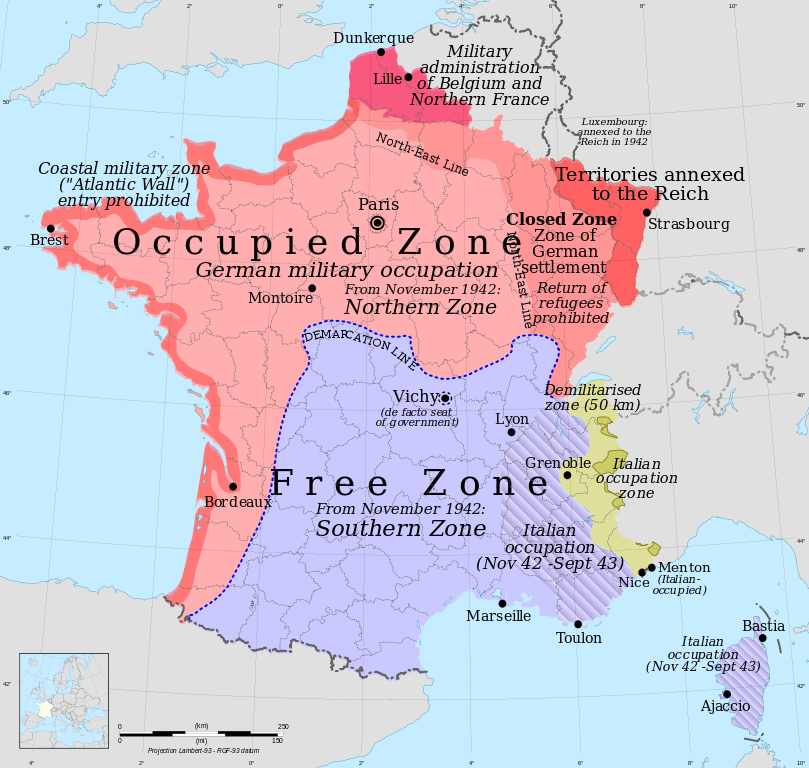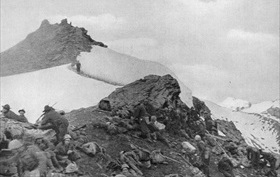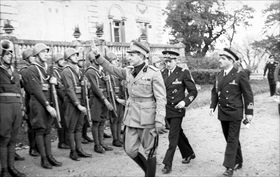HITLER, MUSSOLINI HOLD SUMMIT
Brenner Pass, Austria · March 18, 1940
On this date in 1940 on the Austro-Italian border, German leader Adolf Hitler and Italian strongman Benito Mussolini met for their fifth face-to-face meeting. Hitler had requested the summit in order to force Il Duce (Italian, “the leader”) to take sides within the framework of the so-called Pact of Steel, signed by the foreign ministers of both states the previous May in Berlin. Since then Hitler had destroyed two countries, Czechoslovakia and Poland, while a hesitant Mussolini watched from the sidelines, building up his armed forces and dithering over when and how he would end Italy’s “nonbelligerent status.” The summit did not change Mussolini’s position; instead, he insisted on waiting for “mathematical certainty” before entering the war. The combination of Nazi successes in occupying Denmark and Norway (April 8 to June 8, 1940); the German invasion of Holland, Belgium, and Luxembourg on May 10; and the Battle of France, launched May 14, was precisely the math needed to convince the Duce on May 26, 1940, to declare war on France. “I only need a few thousand dead so that I can sit at the peace conference as a man who has fought,” Mussolini told the Italian Army’s Chief-of-Staff, Marshal Pietro Badoglio. Hitler, however, was not about to share France’s humiliation or French spoils with his junior partner, so he pushed back Mussolini’s declaration of war against France to June 10, 1940. The short-lived Italian offensive into southern France stalled in a mountainous region with few passes suitable for invading armies. During the operation, Italians suffered 1,229 killed or missing and 2,631 wounded. Almost as many men were hospitalized due to frostbite as were wounded in the conflict. On June 24, 1940, France signed an armistice with Italy. The terms allowed Italy to occupy a portion of France along their common border (see map below). Also, from 1940 to 1943, the Italian Navy operated a submarine base at Bordeaux in southwestern France. From there Italian subs participated in the Battle of the Atlantic until Marshal Badoglio, Mussolini’s successor at the helm of government, worked out an armistice of his own between Italy and the Allies in September 1943.
[amazon_carousel widget_type=”ASINList” width=”600″ height=”200″ title=”Recommended Reading” market_place=”US” shuffle_products=”False” show_border=”False” asin=”1906033560,0521582083,185532864X,1929631421,1105074013,0521747139,0230606059,0521338352,1936274299,1477551891″ /]
German and Italian Zones of Occupation in France, 1940–1943
 |
Above: The original Italian zone of occupation (1940–1942) was miniscule and is shown in olive green. A demilitarized zone (light olive) separated Italian armed forces from those of Vichy France (the so-called “Free Zone”). The hash marks extending into the “Free Zone” indicate Italian-occupied Vichy France following Operation Torch, the Allied invasion of Northwest Africa in November 1942. German forces swept in from the north and west to occupy the rest of Vichy.
 |  |
Left: Although Mussolini declared war against France on June 10, 1940, the invaders faced the rugged and steep French western Alps, 7,000–10,000 ft high. Mussolini ordered Marshal Badoglio’s forces to attack French alpine positions on June 18, 1940, but it was not until June 21 that Italians launched an attack. French forces succeeded in limiting Italian penetration so that the last days of the Franco-Italian war were not much different from the previous ones. On June 22, 1940, a French delegation signed the terms of the Franco-German armistice in Compiègne, Northern France, while the next day a French delegation was in Rome to negotiate a similar document, at Hitler’s insistence, between Italy and France. Combat ceased on June 25.
![]()
Right: The Italian Army of occupation in southern France in November 1942 consisted of four infantry divisions of 136,000 soldiers and 6,000 officers, while on the French Mediterranean island of Corsica there were 66,000 soldiers with 3,000 officers. Italians faced no opposition from the collaborationist forces of Vichy France (even after November 1942), and virtually no guerrilla activity was directed against them by members of the French Resistance (Maquis) until the summer of 1943.
Contemporary Newsreel Account of Italy’s Occupation of France (in Italian)
![]()

 History buffs, there is good news! The Daily Chronicles of World War II is now available as an ebook for $4.99 on Amazon.com. Containing a year’s worth of dated entries from this website, the ebook brings the story of this tumultuous era to life in a compelling, authoritative, and succinct manner. Featuring inventive navigation aids, the ebook enables readers to instantly move forward or backward by month and date to different dated entries. Simple and elegant! Click
History buffs, there is good news! The Daily Chronicles of World War II is now available as an ebook for $4.99 on Amazon.com. Containing a year’s worth of dated entries from this website, the ebook brings the story of this tumultuous era to life in a compelling, authoritative, and succinct manner. Featuring inventive navigation aids, the ebook enables readers to instantly move forward or backward by month and date to different dated entries. Simple and elegant! Click 











